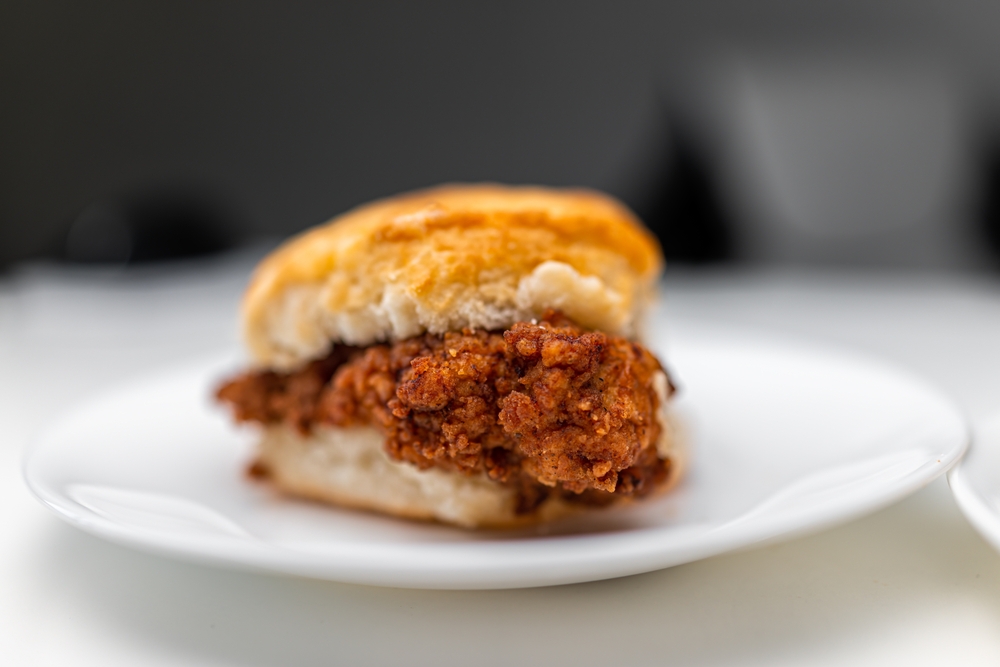Health
This Is for Everyone Who Still Eats at Chick-fil-A

Chick-fil-A’s chicken sandwiches are beloved by many for their flavor and convenience, becoming a staple in the fast food world. However, the ingredients that give these sandwiches their signature taste may hide some unsettling truths. While the fast-paced nature of modern life pushes many toward quick meals, it’s important to take a closer look at what we’re actually consuming.
Recent scrutiny has brought attention to some of the chemicals and additives used in these sandwiches. Although they may seem harmless at first glance, emerging research suggests otherwise. Are these ingredients just the price of convenience, or do they pose risks to our health that we should no longer ignore? The answer might surprise you.

What’s Really Inside Chick-fil-A’s Famous Sandwich?
Chick-fil-A is known for its mouthwatering chicken sandwiches, but few people stop to consider what makes these sandwiches taste so good. While the ingredients might seem simple at first—chicken, bread, pickles, and sauce—there’s much more going on behind the scenes. Some of the additives used to preserve freshness, enhance flavor, and maintain the sandwich’s crispy texture may not be as harmless as they seem.
One of the key concerns is the presence of Dimethylpolysiloxane, an anti-foaming agent used in the oil for frying. This chemical is commonly found in non-food products like caulks, adhesives, and even cosmetics. Although the FDA approves its use in small amounts for cooking, it’s worth asking whether such substances belong in our food at all. The potential health risks linked to Dimethylpolysiloxane include damage to the immune system and hormonal imbalances, making it more than just a simple cooking additive.
Aside from the anti-foaming agent, other chemicals like Monosodium Glutamate (MSG) and preservatives are also used to make the chicken more flavorful and extend its shelf life. While these additives make the product taste better and last longer, they come with their own set of concerns. MSG, for example, has been linked to headaches, nausea, and in some cases, allergic reactions. It’s hard to ignore these risks when they’re hiding in what might seem like a simple meal.
Dimethylpolysiloxane – More Than Just a Kitchen Ingredient?
Dimethylpolysiloxane may sound like a complicated, harmless chemical, but it’s far from an innocent ingredient. Often used in industrial applications, this substance is a silicone-based compound found in products such as adhesives and aquarium sealants. It serves as an anti-foaming agent in Chick-fil-A’s frying oil, preventing the oil from bubbling over during cooking. But is it something we want in our food?
Though the FDA permits its use in cooking, new research has raised questions about its impact on human health. Specifically, concerns have been voiced about its potential effects on the immune system and hormonal balance. While occasional consumption might not lead to immediate harm, long-term exposure could disrupt how the body processes hormones, which may contribute to conditions like thyroid dysfunction or other metabolic disorders.
Moreover, the industrial uses of Dimethylpolysiloxane suggest that it was never intended to be a dietary ingredient. The fact that the same chemical is used to create caulks and adhesives should make us pause. It brings up an important question about whether convenience and cost-cutting measures in the food industry are compromising the quality—and safety—of what we eat.

MSG and Its Impact – Flavor at a Cost?
Monosodium Glutamate, or MSG, has long been used to enhance the flavor of processed foods, including fast food like Chick-fil-A’s chicken sandwiches. It works by stimulating the taste buds, creating a savory, umami flavor that makes the food more appealing. But what’s the cost of this flavor boost? While some argue that MSG is perfectly safe when consumed in moderation, others link it to a variety of health issues.
Headaches, nausea, and allergic reactions are among the most common side effects associated with MSG consumption. For people who are sensitive to it, even small amounts can trigger uncomfortable symptoms. In addition to these short-term effects, some studies have suggested that MSG might also play a role in more serious conditions like obesity. By overstimulating the taste buds, MSG could encourage overeating, contributing to weight gain and other metabolic problems.
There’s also the issue of long-term exposure. With MSG hidden in so many fast foods and processed snacks, people may be consuming far more of it than they realize. Over time, this could lead to chronic health issues, including problems with metabolism and weight management. The flavor enhancement that MSG provides might make fast food more addictive, but it comes with serious consequences for overall health.
Preservatives and Their Side Effects – A Deeper Dive
In addition to MSG and Dimethylpolysiloxane, several other preservatives used in Chick-fil-A’s chicken sandwiches are raising eyebrows. One such ingredient is Potassium Sorbate, which is commonly used to prevent spoilage and extend shelf life. While it helps keep the chicken tasting fresh for longer, studies have linked this preservative to allergic reactions and potential toxicity in some organs. Animal studies suggest that excessive exposure to Potassium Sorbate could affect liver and kidney function, although more research is needed to confirm its impact on humans.
Sodium Aluminum Phosphate is another questionable ingredient found in these sandwiches. Often used as a leavening agent in baked goods, this compound has been associated with kidney damage and bone loss when consumed in large amounts. Although the levels present in fast food might not seem alarming, frequent consumption of products containing Sodium Aluminum Phosphate could have cumulative effects, especially for those with pre-existing health conditions.
Then there’s DATEM (Diacetyl Tartaric Acid Esters of Mono- and Diglycerides), a dough conditioner used in many fast food buns. Though the name sounds obscure, this chemical has been linked to respiratory issues in factory workers who are exposed to high concentrations of it. While it’s unlikely that eating a sandwich would expose a person to dangerous levels of DATEM, it’s another example of the hidden additives that fast food chains use to cut costs while possibly compromising health.
Unveiling the “Butter Bun” Misleading Label
One of the more surprising revelations about Chick-fil-A’s chicken sandwiches is the truth behind the “buttered bun.” The chain claims that its chicken sandwich is served on a buttered bun, but a closer look at the ingredients reveals that it’s actually soybean oil and palm kernel oil flavored to taste like butter. This isn’t just a minor misrepresentation; it’s an example of how fast food companies often market their products in ways that can mislead customers.
The difference between real butter and butter-flavored oils isn’t just about taste—it’s also about nutrition. Real butter, when consumed in moderation, can be part of a balanced diet. In contrast, the hydrogenated oils used to mimic butter in fast food are high in unhealthy trans fats. These oils can raise cholesterol levels and increase the risk of heart disease, making the “butter bun” far less healthy than it might sound.
For consumers, this kind of labeling can be confusing, especially for those trying to make healthier food choices. The misrepresentation of ingredients, combined with the hidden chemicals and preservatives, shows that fast food may not be as straightforward as it appears. It’s crucial for consumers to dig deeper into what they’re eating and demand more transparency from food companies.
Making Healthier Choices – Fast Food Alternatives
Eating healthier doesn’t mean you have to give up delicious food. In fact, making your own version of a chicken sandwich at home can be both satisfying and nutritious. One of the easiest swaps is to use grilled chicken instead of fried. Grilled chicken retains the protein and flavor without the extra fat and chemicals that come from deep frying. Plus, it’s much easier on your digestive system and waistline.
Another healthy option is to switch to whole grain or whole wheat buns. These buns offer more fiber, which helps keep you full for longer and supports digestive health. You can also load your sandwich with fresh vegetables like lettuce, tomatoes, and avocado, which add nutrients and flavor without the need for artificial additives. By controlling the ingredients, you can enjoy a delicious sandwich without worrying about hidden chemicals or preservatives.
Finally, air frying your chicken at home can give you the crispy texture you love without the need for unhealthy frying oils. An air fryer uses hot air to cook the food, reducing the need for excessive oil. This method not only cuts down on fat but also eliminates the use of harmful additives like Dimethylpolysiloxane, giving you a much cleaner and healthier meal.
Reclaim Your Plate: Choosing Health Over Hype
Fast food can be convenient, but the hidden costs to your health are too significant to ignore. The ingredients in Chick-fil-A’s famous chicken sandwiches, from chemical preservatives to flavor enhancers, pose potential risks that go beyond a quick meal. While they may offer a tempting solution to a busy day, they come loaded with additives that could harm your body over time. Taking a closer look at what’s inside these meals is the first step toward reclaiming control over your health.
Fortunately, you don’t have to settle for less. There are plenty of ways to enjoy flavorful, satisfying food without compromising your well-being. Whether it’s swapping out deep-fried chicken for grilled or choosing whole grain buns, small changes can make a big difference. By taking the time to prepare meals at home or making informed choices when eating out, you can avoid the pitfalls of processed fast food and prioritize your health.
In the end, your food choices are about more than just taste—they’re about taking charge of your long-term well-being. By opting for healthier alternatives and being mindful of what goes into your meals, you can enjoy delicious food without the risks that come with hidden ingredients. It’s time to reclaim your plate and make choices that reflect your commitment to a healthier, happier life.
Typos, corrections and/or news tips? Email us at Contact@TheMindUnleashed.com
